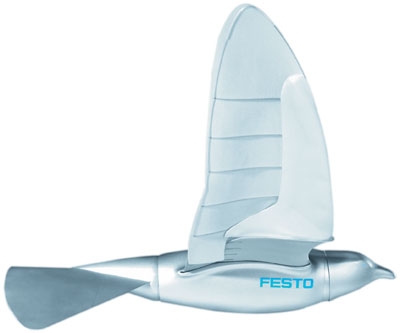Festo has come up with some innovative designs of lightweight, flying robots like the SmartBird, AirPenguin, AirJelly etc. The SmartBird is essentially an ornithopter, which flaps and swoops around a large empty hall at Festo’s manufacturing plant. Festo is a German based automation company which specialises in pneumatic and electrical actuators.
 Festo's Smart Bird
Festo's Smart Bird
The Bionic Learning Network (BLN) designed and developed the SmartBird, in collaboration with universities such as Massachusetts Institute of Technology (MIT), Stuttgart, Berlin Cornell and Delft. The BLN focuses on developing lightweight industrial robots. BLN works to bring out new forms of robotic devices inspired by nature and which are a combination of mechatronics, pneumatics and robotics.
Festo is looking at deploying the robots in industries where there is a need for close interaction with humans, such as, handling industry, packaging industry, agriculture, assisted living and household applications. The BLN projects incorporate two particular technologies in building the robots, namely, fluidic muscle and fin-ray effect. The former is based on pneumatic drive principles and employs a hollow cylinder made of stretchy polymer in which fibres of an aramid material are embedded. These fibres create a movement similar to human muscle movement and are capable of exerting 10 times the force exerted by a pneumatic cylinder of a similar size. Festo claims that this can be used in extreme conditions of sand and dust. The fin-ray effect emulates the physiology of fish and is made up of two fixed struts joined at their tip, such that an acute triangle is formed.
Festo has designed the AirPenguin, the water-going Airacuda and the SmartBird using these two principles. Using the fin-ray units, Festo has designed the Bionic Tripod, which is a ball-and-socket joint that gives a wrist like motion and can be used for gripping fragile objects. Another interesting invention is the milking robot, that lets the cows take control over when they want to be milked. Whenever a cow wants to be milked it walks into the milking bay and a pneumatic arm equipped with a laser sensor to detect the udder’s position, starts milking the cow. The main advantage of lightweight robotics is that small amount of energy is consumed while shifting weights.